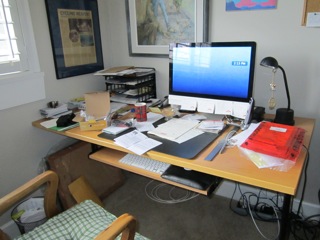This week I will begin a new book. But, before I write the first sentence, I embark on a ritual that readies me for the journey ahead. I need to get my website up-to-date, a task that seems to stall when a book is in progress. Then, with my cyber-world in order, I will tackle my writing room with an aim to transform the jumble of notes, books, and files on my desk and around the room into clear, uncluttered space.

The visual appearance of where I write affects my clarity and productivity as much as the state of my interior landscape. To be present and focused, distractions must go. That includes the materials and reminders of my last book, an illustrated biography of the great Canadian writer and artist Ted Harrison.
The residue from that four-year project still fills nooks and crannies of my study. It is time to sift and sort. I will archive some materials and store them under the stairs. But most of what was once essential is not longer important and can go. Now I have space on bookshelves, a clear bulletin board and empty file drawers for my current project. Later, I’ll sweep from my desk the minutiae of everyday life that represented in bank statements to be filed, magazines to recycle and orphaned bits of this and that.

But I know this newly cleared space will be temporary. As I build the next book, my study will transform into a visual record of that writing process. Reference books, photos, notes, tapes, letters and random thoughts scribbled on scraps of paper will find homes in the space around me.
The personalities of my characters will speak to me through these static facsimiles. Together we will inhabit an environment that will be utterly our own. It will change as we go deeper into knowing each other. And so it will be until we reach THE END, when they too, will be sorted and either discarded or packed into storage boxes.
When I reflect upon my student days, I see that even then, I needed a composed external space to put my internal world at ease. Because I am a visual person — someone who instinctively piles rather than files — this is a constant challenge.
In the past, I’d convinced myself I knew where things were, even if my working space was a confusion of chaos. I’ve since learned that I am more productive, clear and focused when it is calm and orderly.
With space for my new book to grow, and with plant or two, a few pretty pictures and a little light jazz to keep my company, the scene is set for my next writerly adventure.

Katherine Gibson is the author of Unclutter Your Life: Transforming Your Physcial, Mental and Emotional Space; Pause: Putting the Brakes on a Runaway Life and Ted Harrison Painting Paradise.

